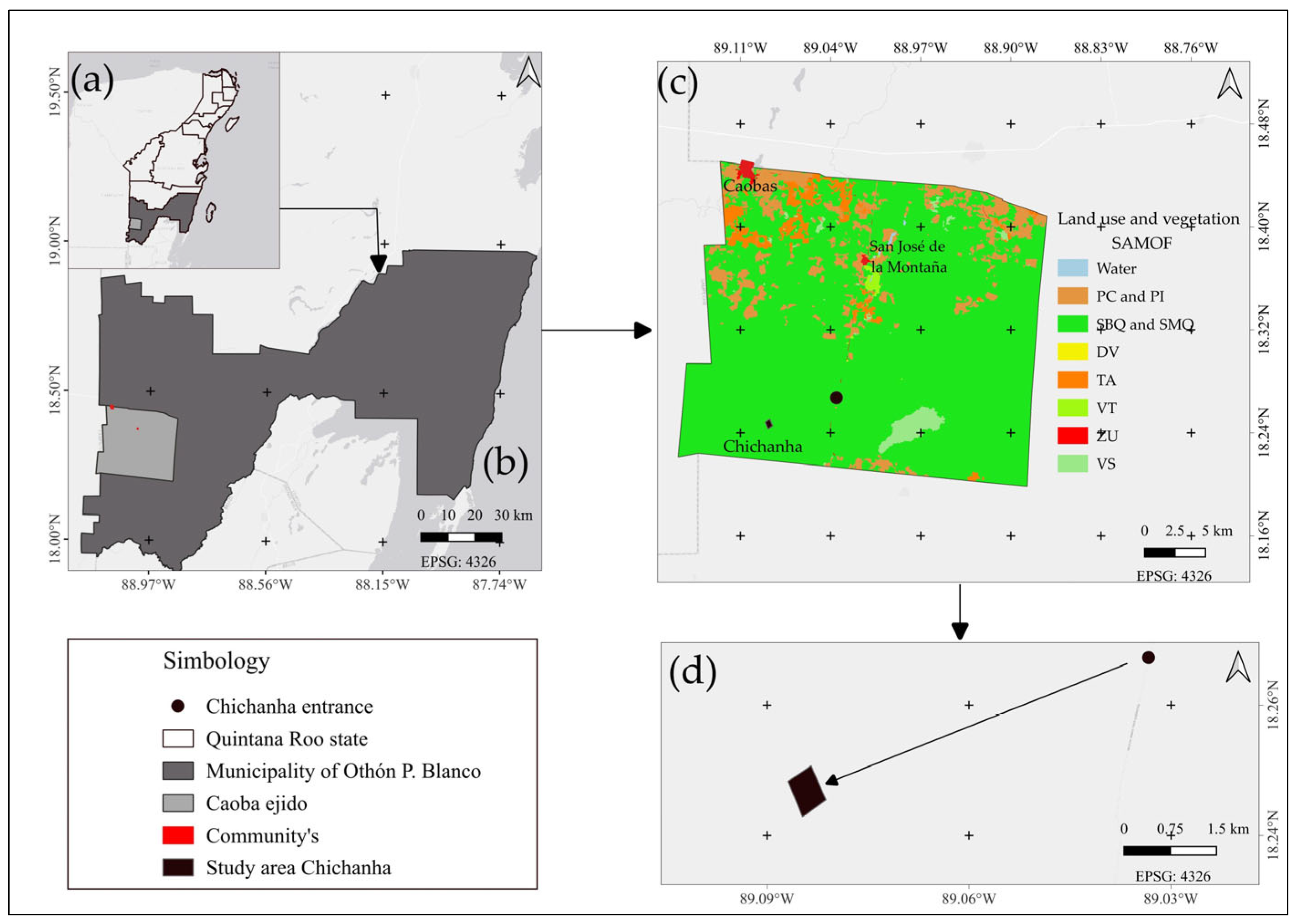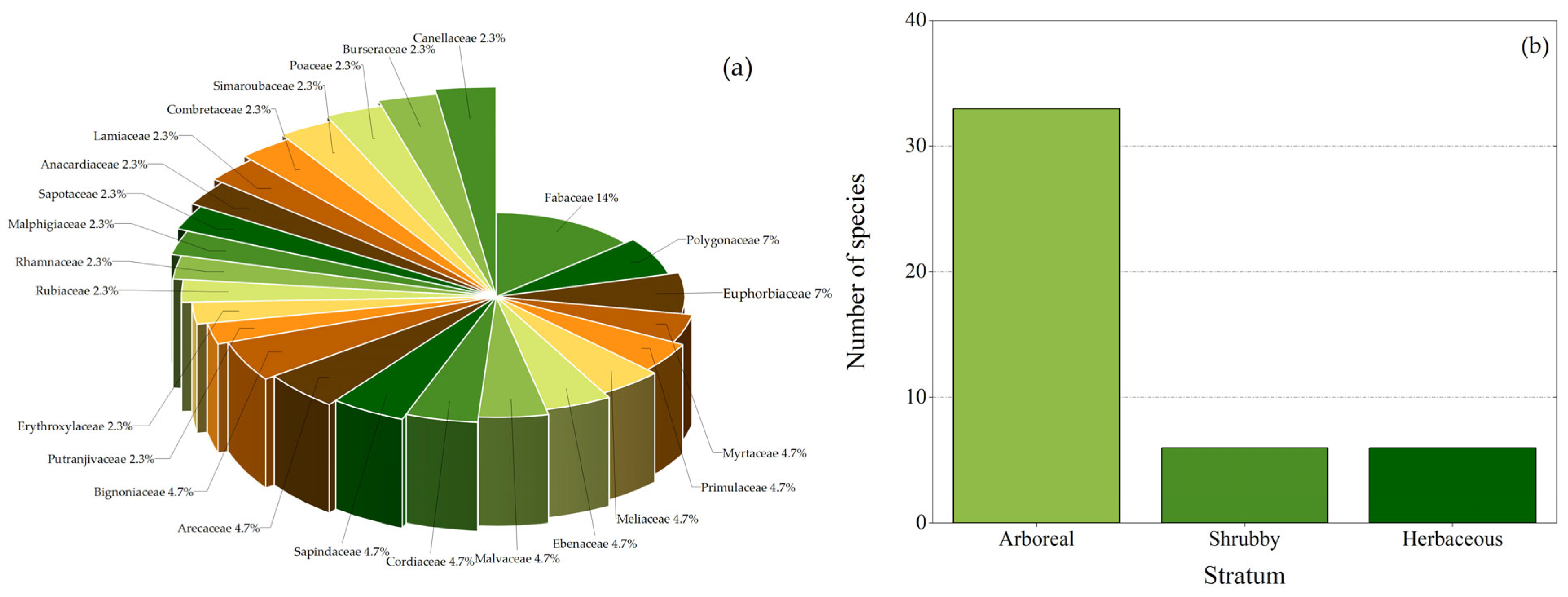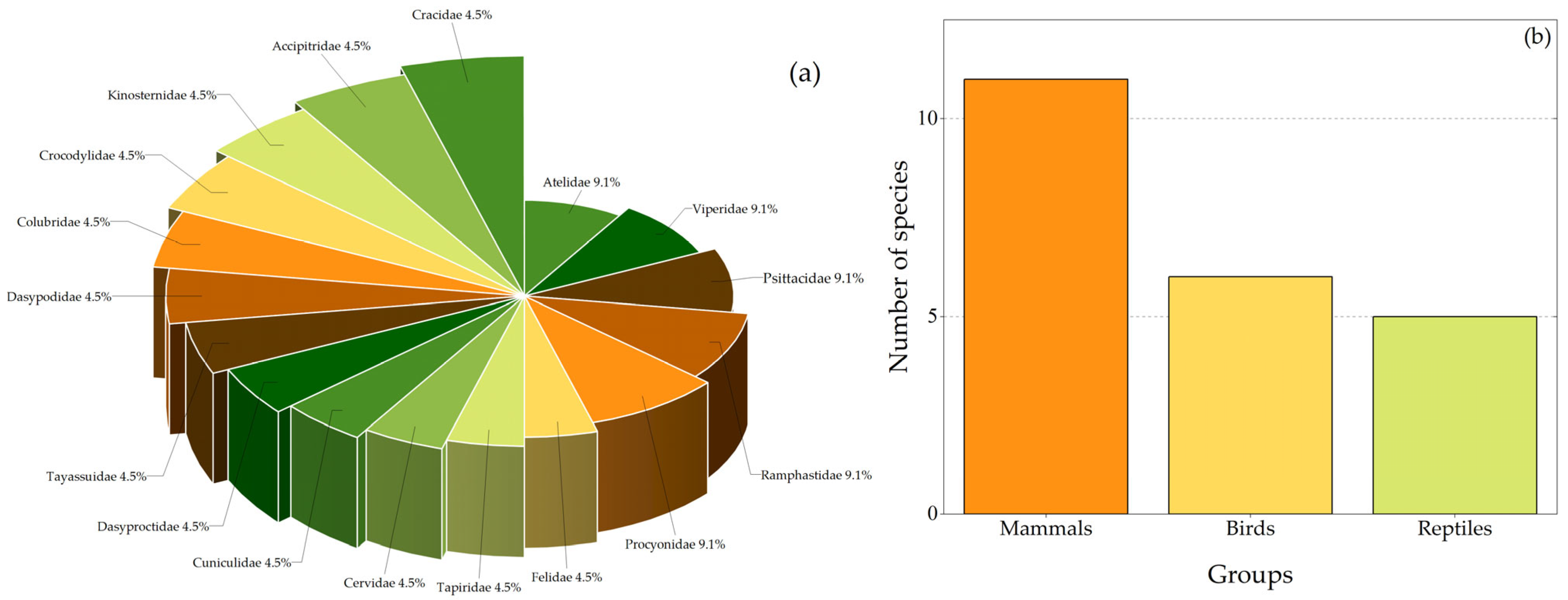The Tourist Carrying Capacity as a Basis for Sustainable Management of Ecotourism Activities: Case Study of the Southern Mexican Caribbean
Abstract
1. Introduction
2. Literature Review
Tourist Carrying Capacity in the Context of Ecotourism and Sustainable Tourism Management
3. Materials and Methods
3.1. Study Area
3.2. Description of Flora and Fauna in the Study Area
3.3. Social Mapping and Diagnosis of the Communities in the Study Area
3.4. Estimation of Tourism Carrying Capacity (TCC)
4. Results
4.1. Characterization of Flora and Fauna
4.1.1. Flora
4.1.2. Fauna
4.2. Social Mapping and Diagnosis in the Study Area
4.3. Tourism Carrying Capacity for Ecotourism Activities in the Study Area
4.3.1. PCC
4.3.2. RCC
4.3.3. ECC
5. Conclusions
Supplementary Materials
Author Contributions
Funding
Institutional Review Board Statement
Informed Consent Statement
Data Availability Statement
Conflicts of Interest
References
- Barragán, J.M.; de Andrés, M. Expansión Urbana En Las Áreas Litorales de América Latina y Caribe. Rev. Geogr. Norte Gd. 2016, 64, 129–149. [Google Scholar] [CrossRef]
- Bazant-Fabre, O.; Bonilla-Moheno, M.; Martínez, M.L.; Lithgow, D.; Muñoz-Piña, C. Land Planning and Protected Areas in the Coastal Zone of Mexico: Do Spatial Policies Promote Fragmented Governance? Land Use Policy 2022, 121, 106325. [Google Scholar] [CrossRef]
- UNWT. ONU Turismo y el Sistema de las Naciones Unidas|ONU Turismo. Available online: https://www.unwto.org/es/onu-turismo-sistema-naciones-unidas (accessed on 7 December 2024).
- Matos-Márquez, L.A.; Pérez-Colmenares, S.V. Revisión sobre capacidad de carga turística y la prevención de problemas ambientales en destinos emergentes. Tur. Soc. 2018, 24, 77–100. [Google Scholar] [CrossRef]
- DATATUR. Datatur3—RankingOMT. Available online: https://datatur.sectur.gob.mx/SitePages/RankingOMT.aspx (accessed on 7 December 2024).
- SEDETUR. Indicadores Turísticos Enero—Diciembre 2019. Available online: https://sedeturqroo.gob.mx/ARCHIVOS/indicadores/Indicador-Tur-Dic-2019.pdf (accessed on 7 December 2024).
- Guimarais, M.; Zúñiga-Ríos, A.; Cruz-Ramírez, C.J.; Chávez, V.; Odériz, I.; van Tussenbroek, B.I.; Silva, R. The Conservational State of Coastal Ecosystems on the Mexican Caribbean Coast: Environmental Guidelines for Their Management. Sustainability 2021, 13, 2738. [Google Scholar] [CrossRef]
- SEDETUR. Secretaría de Turismo|Transparenciafocalizada.qroo.gob.mx. Available online: https://transparenciafocalizada.qroo.gob.mx/sedetur (accessed on 7 December 2024).
- de Esteban-Curiel, J.; Antonovica, A. El ecoturismo como modelo internacional de desarrollo sostenible del turismo cultural. Teor. Prax. 2010, 8, 43–53. [Google Scholar] [CrossRef]
- Cador-McCoy, C.E.; Sosa-Ferreira, A.P.; Sosa-Ferreira, A.P. Causas y efectos de un destino no sustentable: Caso playas públicas de Cancún, Quintana Roo. Periplo Sustentable 2016, 31, 1–16. Available online: https://www.scielo.org.mx/scielo.php?script=sci_arttext&pid=S1870-90362016000200006 (accessed on 7 December 2024).
- Gayosso-Soto, E.; Cohuo, S.; Sánchez-Sánchez, J.A.; Macario-González, L.; Villegas-Sánchez, C.A.; Medina-Quej, A.; Tello-Chan, J.M.; Cutz-Pool, L.Q.; Castro-Pérez, J.M. The Environmental Legal Framework of Mexican Caribbean Dunes: A Retrospective Case Study of Vegetation and Coastal Dune Loss in the Sian Ka’an Biosphere Reserve. Land 2024, 13, 1533. [Google Scholar] [CrossRef]
- García, C.M.; Casallas, J.F.R.; Riveros, O.C.V.; Valderrama, A.M. Turismo sostenible: Una conceptualización de su viabilidad para el municipio de Ibagué, desde un estado del arte pertinente. PASOS Rev. Tur. Patrim. Cult. 2017, 15, 21–34. [Google Scholar]
- Ganzo-Olivares, J.; Quintal-García, N.A.; Sánchez-Méndez, L.G.; Tamayo-Garza, J.F.; Vega-Cadena, U.J. Turismo Rural: Estrategia de Desarrollo Para las Comunidades de la Ribera del Río Hondo Quintana Roo, México. EBSCOhost. Available online: https://openurl.ebsco.com/contentitem/gcd:134728298?sid=ebsco:plink:crawler&id=ebsco:gcd:134728298 (accessed on 7 December 2024).
- Ceballos-Lascuráin, H. Tourism, Ecotourism, and Protected Areas: The State of Nature-Based Tourism Around the World and Guidelines for Its Development. Available online: https://iucn.org/resources/publication/tourism-ecotourism-and-protected-areas-state-nature-based-tourism-around (accessed on 7 December 2024).
- Ibañez-Pérez, R. Capacidad de carga turística como base para el manejo sustentable de actividades ecoturísticas en Unidades de Manejo Ambiental (UMA) de Baja California Sur (BCS). Periplo Sustentable 2016, 30, 37–76. Available online: https://www.scielo.org.mx/scielo.php?pid=S1870-90362016000100037&script=sci_abstract&tlng=pt (accessed on 7 December 2024).
- Cifuentes, M.; Mesquita, C.A.B.; Méndez, J.; Morales, M.; Aguilar, N.; Cancino, D.; Gallo, M.; Jolón, M.; Ramírez, C.; Ribeiro, N. Capacidad de Carga Turística de Las Áreas de Uso Público del Monumento Nacional Guayabo, Costa Rica. 1999. Available online: https://www.semanticscholar.org/paper/Capacidad-de-Carga-Turística-de-las-Áreas-de-Uso-Arias-Mesquita/f2c1b3b15cd0ade5fcee75d9596af8d78e9eb6cc (accessed on 7 December 2024).
- Morales-Betancourt, D. Capacidad de Carga Física y Real Para Atractivos Turístico Priorizados y Vías de Acceso en el Casco Urbano de Puerto Nariño, Amazonas (Physical and Real Carrying Capacity for Priority Tourism Attractions and Access Routes at the Urban Area of Puert O Nariño, Amazonas). 2015. Available online: https://papers.ssrn.com/sol3/papers.cfm?abstract_id=2646716 (accessed on 7 December 2024).
- Fernández, M.F.; Lazovski, O. La capacidad de carga de un municipio turístico a través de la estimación del tamaño “real” de la población: Dificultades y propuestas. Int. J. Sci. Manag. Tour. 2018, 4, 93–108. [Google Scholar]
- Montalvo-Vargas, R.; Castillo-Ramiro, J.J. Estimación de la capacidad de carga turística en agua selva (Tabasco—México): Base para la planificación y el desarrollo regional. Estud. Perspect. Tur. 2018, 27, 295–315. [Google Scholar]
- Alvarado-Sànchez, M.; Miranda-Álvarez, P.; Mora-Aparicio, K. La capacidad de carga turistica como herramienta de planificación en una iniciativa de turismos rural comunitario: Caso de La Posada Rural La Amistad, Isla de Chira, Golfo de Nicoya Costa Rica. Doc. Geogr. 2018, 2, 121–143. [Google Scholar] [CrossRef]
- Huaroc-Ponce, E.J.; Raqui-Ramirez, C.E.; Jurado-Taipe, R.S.; Huaroc-Ponce, N.M. Capacidad de carga Turística, base para el manejo sustentable: Gruta de Huagapo. Puriq 2021, 3, 34–46. [Google Scholar] [CrossRef]
- Cifuentes, M. Determinación de Capacidad de Carga Turística en Áreas Protegidas. Costa Rica. 1992. Available online: https://www.ucm.es/data/cont/media/www/pag-51898/1992_METODOLOGÍA%20CIFUENTES.pdf (accessed on 21 November 2024).
- Sobhani, P.; Esmaeilzadeh, H.; Sadeghi, S.M.M.; Marcu, M.V. Estimation of ecotourism carrying capacity for sustainable development of protected areas in Iran. Int. J. Environ. Res. Public Health 2022, 19, 1059. [Google Scholar] [CrossRef] [PubMed]
- Long, C.; Lu, S.; Chang, J.; Zhu, J.; Chen, L. Tourism environmental carrying capacity review, hotspot, issue, and prospect. Int. J. Environ. Res. Public Health 2022, 19, 16663. [Google Scholar] [CrossRef] [PubMed]
- Tokarchuk, O.; Gabriele, R.; Maurer, O. Estimating tourism social carrying capacity. Ann. Tour. Res. 2021, 86, 102971. [Google Scholar] [CrossRef]
- Garau, G.; Carboni, D.; Karim El Meligi, A. Economic and environmental impact of the tourism carrying capacity: A local-based approach. J. Hosp. Tour. Res. 2022, 46, 1257–1273. [Google Scholar] [CrossRef]
- Zelenka, J.; Kacetl, J. Visitor management in protected areas. Czech J. Tour. 2013, 2, 5–18. [Google Scholar] [CrossRef]
- Sharma, R. Evaluating total carrying capacity of tourism using impact indicators. Glob. J. Environ. Sci. Manag. 2016, 2, 187. [Google Scholar]
- Skiniti, G.; Lilli, M.; Skarakis, N.; Tournaki, S.; Nikolaidis, N.; Tsoutsos, T. A holistic approach for tourism carrying capacity estimation in sensitive ecological areas. Environ. Dev. Sustain. 2024, 26, 31971–31995. [Google Scholar] [CrossRef]
- Butler, R. Tourism area life cycle. Contemp. Tour. Rev. 2014, 1, 183–226. [Google Scholar]
- Hall, C.M. Tourism: Conceptualisations, disciplinarity, institutions and issues. In The Wiley Blackwell Companion to Tourism; John Wiley and Sons: Hoboken, NJ, USA, 2024; pp. 1–13. [Google Scholar]
- Yfantidou, G.; Matarazzo, M. The future of sustainable tourism in developing countries. Sustain. Dev. 2017, 25, 459–466. [Google Scholar] [CrossRef]
- Butler, R.W. Tourism carrying capacity research: A perspective article. Tour. Rev. 2020, 75, 207–211. [Google Scholar] [CrossRef]
- Pizzitutti, F.; Walsh, S.J.; Rindfuss, R.R.; Gunter, R.; Quiroga, D.; Tippett, R.; Mena, C.F. Scenario planning for tourism management: A participatory and system dynamics model applied to the Galapagos Islands of Ecuador. J. Sustain. Tour. 2017, 25, 1117–1137. [Google Scholar] [CrossRef]
- Driml, S.; Common, M. Ecological economics criteria for sustainable tourism: Application to the great barrier reef and wet tropics world heritage areas, Australia. J. Sustain. Tour. 1996, 4, 3–16. [Google Scholar] [CrossRef]
- Holland, K.K.; Larson, L.R.; Powell, R.B.; Holland, W.H.; Allen, L.; Nabaala, M.; Tome, S.; Seno, S.; Nampushi, J. Impacts of tourism on support for conservation, local livelihoods, and community resilience around Maasai Mara National Reserve, Kenya. J. Sustain. Tour. 2022, 30, 2526–2548. [Google Scholar] [CrossRef]
- Sulis, A.; Carboni, A.; Manca, G.; Yezza, O.; Serreli, S. Impacts of climate change on the tourist-carrying capacity at La Playa beach (Sardinia, IT). Estuar. Coast. Shelf Sci. 2023, 284, 108284. [Google Scholar] [CrossRef]
- Makhadmeh, A.; Al-Badarneh, M.; Rawashdeh, A.; Al-Shorman, A. Evaluating the carrying capacity at the archaeological site of Jerash (Gerasa) using mathematical GIS modeling. Egypt. J. Remote Sens. Space Sci. 2020, 23, 159–165. [Google Scholar] [CrossRef]
- Chougule, B. Environmental carrying capacity and ecotourism development. Int. J. Econ. Issues 2011, 4, 45–54. [Google Scholar]
- RAN-PHINA. Registro Agrario Nacional—PHINA—Padrón e Historial de Núcleos Agrarios. Available online: https://phina.ran.gob.mx/index.php (accessed on 7 December 2024).
- INEGI. Censo de Población y Vivienda 2020. Available online: https://www.inegi.org.mx/programas/ccpv/2020/ (accessed on 21 November 2024).
- Castillo-Ojeda, S.G. El Ejido y la Organización Política en Caobas, Quintana Roo. Bachelor’s Thesis, Universidad de Quintana Roo, Chetumal, Mexico, 2005. Available online: https://risisbi.uqroo.mx/handle/20.500.12249/3085 (accessed on 7 September 2024).
- González-Abraham, A.; Schmook, B.; Calmé, S. Distribución espacio-temporal de las actividades extractivas en los bosques del ejido Caoba, Quintana Roo. Investig. Geogr. 2007, 62, 70–86. Available online: https://www.scielo.org.mx/scielo.php?script=sci_arttext&pid=S0188-46112007000100005 (accessed on 21 November 2024). [CrossRef]
- NOM-107-SCT3-2019; Que Establece Los Requerimientos Para Operar Un Sistema de Aeronave Pi-Lotada a Distancia (RPAS) En El Espacio Aéreo Mexicano. DOF NORMA Oficial Mexicana: Ciudad de México, Mexico, 2019. Available online: https://www.dof.gob.mx/normasOficiales/8006/sct11_C/sct11_C.html (accessed on 1 September 2024).
- Reuter, M.; Schulz, C.; Marrufo, C. Manual Técnico Forestal-GTZ; GTZ-SEMARNAP: Chetumal, Mexico, 1998; Volume 1, Available online: https://www.scribd.com/document/399352478/Manual-Tecnico-Forestal-GTZ (accessed on 7 September 2024).
- Rivas-Torres, D. Evaluación de los Recursos Forestales. 2006. Available online: https://openknowledge.fao.org/items/1c0b62a7-4d27-42b2-8537-8b0a52cd9920 (accessed on 7 September 2024).
- Sánchez-Pérez, L.C. Plan de manejo para propiciar el aprovechamiento forestal sustentable de la Selva Mediana Subperennifolia del Ejido X-Hazil y Anexos, Felipe Carrillo Puerto, Quintana Roo. Master’s Thesis, Unversidad de Quintana Roo, Chetumal, Mexico, 2014. Available online: https://risisbi.uqroo.mx/handle/20.500.12249/147 (accessed on 7 September 2024).
- Expósito, M.; Diagnóstico Rural Participativo. Una Guía Práctica|FAO. 2003. Available online: https://books.google.com.mx/books?id=ntxx0AEACAAJ (accessed on 7 September 2024).
- Manzanilla, J.; Péfaur, J.E. Consideraciones sobre métodos y técnicas de campo para el estudio de anfibios y reptiles. Rev. Ecol. Lat. Am. 2000, 7, 14–17. [Google Scholar]
- Arellano-Rodríguez, J.A.; Flores, J.S.; Tun, J.; Cruz-Bojórquez, M.M. Nomenclatura, Forma de Vida, Uso, Manejo y Distribución de las Especies Vegetales de la Península de Yucatán; Etnoflora yucatanense; Fascicle 20; Universidad Autónoma de Yucatán, Facultad de Medicina Veterinaria y Zootecnia: Mérida, Mexico, 2003; ISBN 978-970-698-038-0. Available online: https://www.researchgate.net/publication/303517248_Nomenclatura_forma_de_vida_uso_manejo_y_distribucion_de_las_especies_vegetales_de_la_Peninsula_de_Yucatan (accessed on 21 November 2024).
- Pennington, T.D.; Sarukhán, J. Arboles Tropicales de México: Manual para la Identificación de las Principales Especies; UNAM: Mexico City, Mexico, 2005; ISBN 978-970-32-1643-7. [Google Scholar]
- Gallina-Tessaro, S.; López-González, C. Manual de Técnicas Para el Estudio de la Fauna Silvestre; Instituto de Ecología, A.C.: Xalapa, Mexico, 2011; Volume 1, ISBN 978-607-7740-98-8. [Google Scholar]
- Aranda-Sánchez, J.M. Manual Para el Rastreo de Mamíferos Silvestres de México. Available online: https://www.biodiversitylibrary.org/item/197385 (accessed on 9 October 2024).
- SNIB-CONABIO. Sistema Nacional de Información Sobre Biodiversidad (SNIB) de México. Available online: https://www.snib.mx/ (accessed on 9 October 2024).
- CICY. Flora: Península de Yucatán. Available online: https://www.cicy.mx/sitios/flora%20digital/bibliografia.html (accessed on 9 October 2024).
- Tropicos. Tropicos—Home. Available online: https://www.tropicos.org/home (accessed on 9 October 2024).
- Cury, S.P.; Arias-Astray, A. Hacia una definición actual del concepto de «diagnóstico social». Breve revisión bibliográfica de su evolución. Alternativas. Cuad. Trab. Soc. 2016, 23, 9–24. [Google Scholar] [CrossRef]
- Torres, M.; Salazar, F.G.; Paz, K. Métodos de Recolección de Datos Para una Investigación. 2006. Available online: http://148.202.167.116:8080/xmlui/handle/123456789/2817 (accessed on 9 October 2024).
- Balcazar, F.E. Investigación acción participativa (iap): Aspectos conceptuales y dificultades de implementación. Fundam. Humanidades 2003, 4, 59–77. [Google Scholar]
- Zapata, F.; Rondán, V. Investigacion Accion Participativa IAP Zapata y Rondan—La investigación—Acción Participativa; Serie Manuales y Herramientas para la Adaptación; Agencia de los Estados Unidos para el desarrollo Internacional (USAID); Instituto de Montaña: Lima, Peru, 2016. [Google Scholar]
- García-Hernández, M.; de la CAlle-VaqueroVaquero, M. Capacidad de carga en grandes recursos turístico-culturales. An. Geogr. Univ. Complut. 2012, 32, 253–274. [Google Scholar] [CrossRef]
- Martínez-Ramos, M.; García-Orth, X. Sucesión ecológica y restauración de las selvas húmedas. Bot. Sci. 2007, 80S, 69–84. [Google Scholar] [CrossRef]
- Navarro-Martínez, A.; Durán-García, R.; Méndez-González, M. El impacto del huracán Dean sobre la estructura y composición arbórea de un bosque manejado en Quintana roo, México. Madera Bosques 2012, 18, 57–76. [Google Scholar] [CrossRef]
- Flores-Guido, J.S.; Espejel-Carbajal, M.I. Tipos de Vegetación de la Península de Yucatán; Etnoflora yucatanense Fascículo; Universidad Autónoma de Yucatán: Mérida, Mexico, 1994; ISBN 978-968-6843-44-6. [Google Scholar]
- Aguirre-Cortés, E.; Escalona-Segura, G.; Macario-Mendoza, P.A.; León-Cortés, J.L.; Sánchez-Pérez, L.C.; Schmook, B. Aprovechamiento forestal y diversidad arbórea en seis ejidos de Quintana Roo. Rev. Mex. Cienc. For. 2020, 11, 79–96. [Google Scholar] [CrossRef]
- García-Trujillo, Z.H.M.K.; Torres-Pérez, J.A.; Avitia-Deras, A.; Cázares-Moran, M.A.; Abrego-Valenzuela, A.P. El Manejo Forestal Como Eje de Desarrollo Del Ejido Felipe Carrillo Puerto, Quintana Roo. LATAM Rev. Latinoam. Cienc. Soc. Humanid. 2023, 4, 2089–2098. [Google Scholar] [CrossRef]
- Peña-Azcona, I.; Ortega-Argueta, A.; García-Barrios, R.; Elizondo, C.; Peña-Azcona, I.; Ortega-Argueta, A.; García-Barrios, R.; Elizondo, C. Áreas de conservación voluntaria en México: Alcances y desafíos. Rev. Cienc. Ambient. 2022, 56, 120–145. Available online: https://www.redalyc.org/journal/6650/665073102007/html/ (accessed on 6 December 2024). [CrossRef]
- Morett-Sánchez, J.C.; Cosío-Ruiz, C. Outlook of Ejidos and Agrarian Communities in México. Agric. Soc. Desarro. 2017, 14, 125–152. [Google Scholar]
- Puente-Santos, E.D.; Pérez-Ramírez, C.A.; Solís-Barrón, C.I. Capacidad De Carga En Senderos Turísticos Del Centro De Cultura Para La Conservación Piedra Herrada, México. Quivera Rev. Estud. Territ. 2011, 13, 93–114. [Google Scholar]
- López-Bonilla, J.M.; López-Bonilla, L.M. La capacidad de carga turística: Revisión crítica de un instrumento de medida de sostenibilidad. Periplo Sustentable 2008, 15, 123–150. [Google Scholar] [CrossRef]
- SECTUR. Estudio Sobre la Capacidad de Carga Turística en las Localidades Donde se Ubicarán las Estaciones del Tren Maya; SECTUR: Ciudad de México, Mexico, 2019. Available online: http://sistemas.sectur.gob.mx/dgots/09-estudio-cct-localidades-tren-maya.pdf (accessed on 6 December 2024).
- Gasca-Zamora, J.; Torres, F.; Rojas Martínez, A.; Martínez, E.; Jouault, S.; Morales, F.; Almeida Poot, M.; Almanza, A.; Perez Akaki, P. Tren Maya. Impactos Territoriales y Escenarios de Cambio en la Península de Yucatán; Universidad Nacional Autónoma de México: Ciudad de México, Mexico, 2024; ISBN 978-607-30-9283-8. [Google Scholar]
- ONU-Habitat. ONU-Habitat Analiza el Impacto del Tren Maya. Available online: https://www.onu-habitat.org/index.php/onu-habitat-analiza-el-impacto-del-tren-maya (accessed on 6 December 2024).
- Ken-Rodríguez, C.A.; Monroy-Aguilar, S.; González-Fonseca, F.I. Comunidades de Quintana Roo y el Tren Maya: Las transformaciones territoriales y su aprovechamiento. Rev. Estud. Reg. Nueva Época 2023, 1, 116–145. [Google Scholar] [CrossRef]
- Ritchie, J.; Crouch, G. The Competitive Destination: A Sustainable Tourism Perspective; Tourism Management; CABI: Wallingford, UK, 2000; Volume 21, pp. 1–7. [Google Scholar] [CrossRef]




| % | Value | Rating |
|---|---|---|
| ≤35 | 0 | Unsatisfactory |
| 36–50 | 1 | Slightly satisfactory |
| 51–75 | 2 | Moderately satisfactory |
| 76–89 | 3 | Satisfactory |
| ≥90 | 4 | Highly satisfactory |
Disclaimer/Publisher’s Note: The statements, opinions and data contained in all publications are solely those of the individual author(s) and contributor(s) and not of MDPI and/or the editor(s). MDPI and/or the editor(s) disclaim responsibility for any injury to people or property resulting from any ideas, methods, instructions or products referred to in the content. |
© 2025 by the authors. Licensee MDPI, Basel, Switzerland. This article is an open access article distributed under the terms and conditions of the Creative Commons Attribution (CC BY) license (https://creativecommons.org/licenses/by/4.0/).
Share and Cite
Tello Chan, J.M.; Magio, K.O.; Gayosso Soto, E. The Tourist Carrying Capacity as a Basis for Sustainable Management of Ecotourism Activities: Case Study of the Southern Mexican Caribbean. Sustainability 2025, 17, 7492. https://doi.org/10.3390/su17167492
Tello Chan JM, Magio KO, Gayosso Soto E. The Tourist Carrying Capacity as a Basis for Sustainable Management of Ecotourism Activities: Case Study of the Southern Mexican Caribbean. Sustainability. 2025; 17(16):7492. https://doi.org/10.3390/su17167492
Chicago/Turabian StyleTello Chan, Jorge Manuel, Kennedy Obombo Magio, and Eloy Gayosso Soto. 2025. "The Tourist Carrying Capacity as a Basis for Sustainable Management of Ecotourism Activities: Case Study of the Southern Mexican Caribbean" Sustainability 17, no. 16: 7492. https://doi.org/10.3390/su17167492
APA StyleTello Chan, J. M., Magio, K. O., & Gayosso Soto, E. (2025). The Tourist Carrying Capacity as a Basis for Sustainable Management of Ecotourism Activities: Case Study of the Southern Mexican Caribbean. Sustainability, 17(16), 7492. https://doi.org/10.3390/su17167492



_Li.png)






